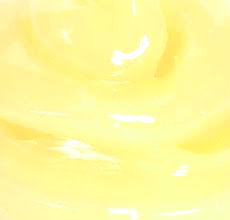| |
Lanolin

|
LANOLIN is an extremely effective emollient in restoring and maintaining the all important hydration (moisture balance) of the stratum corneum, and so prevents drying and chapping of the skin. Equally important, it does not alter the skin's normal transpiration. Lanolin has been shown to cause the water in the skin to build up to its normal level of 10-30%, by retarding without completely inhibiting transepidermal moisture loss. Lanolin has the unique property of absorbing twice its own weight of water. Lanolin has the physical properties of increasing adhesion to dry skin, and forming protective films on the skin. Lanolin is compatible with most fats and waxes used in cosmetics and pharmaceutical preparations. Lanolin is self emulsifying,
Lurified form of wool grease or wool wax (sometimes erroneously called wool fat), used either alone or with soft paraffin or lard or other fat as a base for ointments, emollients, skin foods, salves, superfatted soaps, and fur dressing. Our Lanolin is a light-yellow, soft, unctuous, tenacious substance, is readily absorbed by the skin and thus makes an ideal base for medicinal products intended to be absorbed.
Lanolin is obtained from raw wool by kneading it in water, or by scouring with soap solution, and then centrifuging. The wool grease so obtained is refined, deodorized, and dried.
Chemically, lanolin consists of a mixture of several sterols, fatty acids, and their esters.
A particularly useful property of lanolin is the formation of stable water-in-oil emulsions containing up to 25% water (hydrous lanolin). Major uses are as an emollient and skin moisturizer in lotions and cosmetic products, and in medicinal ointments.
Lanolin was once considered to be a big beauty no-no. Companies would label their product to be 'lanolin-free,' as if the ingredient was an inherently bad thing. Turns out, however, lanolin is one of the most skin-loving ingredients around.
Granted, the ingredient, which is derived from the grease extracted from sheep's wool, doesn't sound pretty. But it offers impressive benefits for the skin. Its molecular structure most closely resembles that of human skin lipids, also, it's a semi-occlusive breathable barrier, so it protects and absorbs at the same time. And once it penetrates into the skin, it holds up to 400 times its weight in water, so it's a fantastic moisture reservoir for skin. In short, lanolin works double-duty; it both moisturises skin from the outside, and helps the skin to moisturise itself from within. The result: baby-soft skin.
Lanolin has been used as a moisturiser since Ancient Greek times. It wasn't until the 1960s that it began to garner a bad name for itself, with consumers reporting allergies to lanolin. It is now known that the real culprit was modern, pesticide-laden farming practices; if lanolin is not highly processed and purified, traces of such chemicals remain in the lanolin, with the potential to trigger allergic reactions down the line. Changes in these practices, as well as developments in processing technology, have allowed for much purer lanolin to hit the market.
Our Lanolin is 100% PURE Pharmaceutical grade USP, extracted from the wool of New Zealand's Merino sheep and provides extreme moisturisation while also having a long lasting protective barrier effect.
Sheep's wool is a natural fiber with several valuable uses. Sheep are shorn every year to keep them healthier and happier. Lanolin is obtained from the wool of the sheep in a completely cruelty free way and there is no animal testing conducted during the sheering processes. This shorn wool is where wool grease (lanolin) is derived once it has been sent to a scrubbing factory where cleaning or 'scouring' of the wool occurs. Scouring is the process of washing the natural grease from the wool. Natural wool grease protects the sheep from the harsh elements and extreme weather conditions by aiding sheep in shedding water from their coats. Certain breeds of sheep produce large amounts of lanolin, and the extraction can be performed by squeezing the wool between rollers. Most or all of the wool grease is removed from wool when it is processed into textiles such as yarn or felt. The raw wool grease is then refined into many different grades of lanolin. The lanolin we offer is of the highest standard called modified pharmaceutical grade lanolin. It is non-toxic, non-hazardous and fully biodegradable. It is environmentally friendly and one of nature's renewable resources.
The Safety of Lanolin
The majority of lanolin used in most cosmetics is contaminated with organo-phosphate pesticides and insecticides. Our lanolin is entirely safe and virtually pesticide free at less than 40 parts per million of all impurities. This is why our lanolin in called hypoallergenic pharmaceutical grade lanolin. Any parasitic control agent applied to the sheep to prevent distress or suffering of the animals is completely removed by the process of modern refining. Refined Lanolin is considered more pure than most foods we consume.
Recent studies indicate that antibiotics are also present in the lanolin. These natural antibiotics help aid in the healing of dry cracked skin, feet, lips and nails, and is perfect for people that frequently wash their hands, such as doctors and nurses.
Disclaimer: The information presented herein is intended for educational purposes only. These statements have not been evaluated by the FDA and are not intended to diagnose, cure, treat or prevent disease. Individual results may vary, and before using any supplements, it is always advisable to consult with your own health care provider.
|
|


















